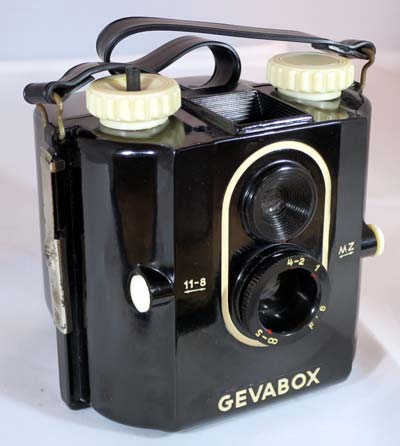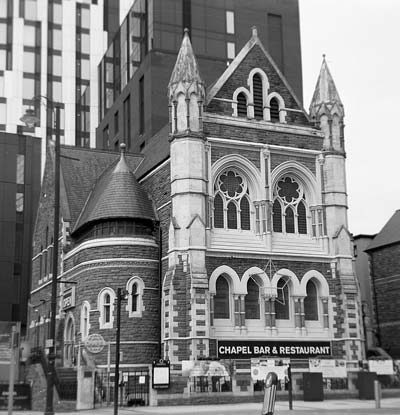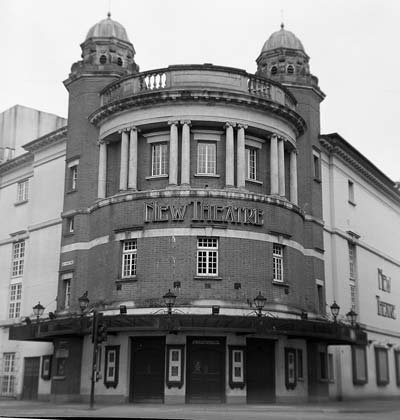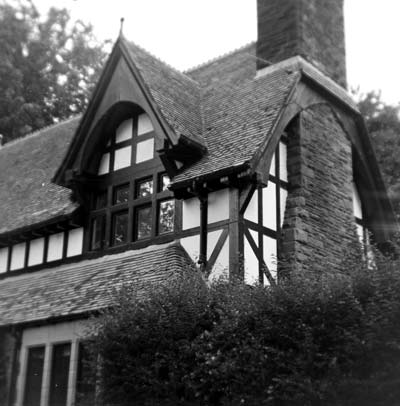Gevaert Gevabox 6x6
Specification

| Manufacturer | : | Gevaert |
|---|---|---|
| Produced | : | 1950 |
| Classification | : | Medium Format |
| Body Type | : | Box |
| Construction | : | Bakelite |
| Film Type | : | 120 |
| Film Width | : | 62mm |
| Image Size | : | 6 x 6 cm |
| No. of Images | : | 12 |
| Lens Type | : | meniscus |
| Focal Length | : | 85mm |
| Focus Type | : | Variable |
| Focal Range | : | 1m - inf. |
| Aperture Type | : | Multihole |
| Apertures | : | f/8, f/11 |
| Shutter Type | : | Rotary |
| Shutter Speeds | : | T, I*(1/100s) |
| Size (w x h x d) | : | 105 x 105 x 107 mm |
| Weight | : | 395g |
| * Measured on this camera | ||
Art Deco Credentials
![]()
![]()
Acceptable: Modest and restricted
I consider this camera to warrant 2 stars for the following attributes:
- produced after the main Art Deco period
- two colour Bakelite
- rounded body corners alluding to Streamline Moderne
- ribbed design on body
- ribbed embellishments to viewfinder, control knobs and red window
- oval design in white around the lens and viewfinder.
- symmetrical body and face
Description
An almost cubic Bakelite box-camera with curved edges. Capable of taking 6x6 cm images on 120 film. The camera was made from for Gevaert by Hermann Wolf GmbH, Wuppertal, Germany from around 1950.
Single-speed + B shutter actuated by a push button on the top. The knob around the shutter release is for show only to give the camera a symmetrical character. A button on the side allows you to choose M(oment) for snapshots or Z(eit) for timed exposure. Film advance is not linked to the shutter so double exposure is possible. There is a threaded port close to the shutter release to allow for the use of a cable release. The nominal shutter speed is 1/50s but on this camera it measured 1/100s. The lens has a nominal f/8 aperture but can be stopped down to f/11. The front focussing gives a range from 1 m to infinity. The markings on the rotating lens bezel are 1, 4 - 2 and 5 - ∞ and are in metres.
It has a single waist-level brilliant viewfinder. Film advance control is via red window. Sliding catches on the sides give access to the film transport system. The back of the camera is removed to load the film. It has a single ¼" tripod mount on the base of the camera. There is also a synchro version with flash contacts on the bottom plate.
How to Use
This camera takes 120 film which is widely available. It is advisable to cover the red window except when winding film in low light.
The nominal aperture choice is f/8 or f/11. However, aperture calculations reveal that these are more like f/10 and f/14. The nominal speed of the this camera is 1/50s. The measured speed on this camera was 1/100s. I have used the measured values to construct the table below. This shows how important it is to measure the aperture and shutter speeds of vintage cameras before attempting to use them if you want reasonable exposures. Using the nominal values to calculate exposure could lead to under-exposure by up to 1½ stops.
As the shutter speed is only 1/100s, it is advisable to use a tripod to get clear shake free images. However, holding it against a wall or other solid object would work as well. For quick snapshots, hold it firmly against your body.
The table shows how this camera will perform using ISO 100 film. It is based on the 'Sunny 16' rule. Modern film is so forgiving and will produce acceptable results even when overexposed by 2 or 3 stops or underexposed by 1 stop.
The tables assume that the sun is at least 30 degrees above the horizon - that's 10am - 5pm on a summers day (May-August) in the UK.
Remember that the exposure guide in the manual may not be helpful as it is based on the use of old film with a low ISO value.
Using ISO 100/125 film - shutter speed 1/100s
| Weather Conditions | Shadow Detail | Nominal Aperture | Exposure |
|---|---|---|---|
 Sunny SunnySnow/Sand | Dark with sharp edges | f/11 | +1 Stops Overexposed Acceptable |
 Sunny Sunny | Distinct | f/11 | Good |
 Slight Overcast Slight Overcast | Soft around edges | f/8 | Good |
 Overcast Overcast | Barely visible | f/8 | -1 Stop Underexposed Acceptable |
 Heavy Overcast Heavy Overcast | None | f/8 | -2 Stops Underexposed Not Acceptable |
 Open Shade Open Shade/Sunset | None | f/8 | -3 Stops Underexposed Not Acceptable |
Photographs taken with this Camera
Ilford FP4+.
Developed in D76(1+1).



